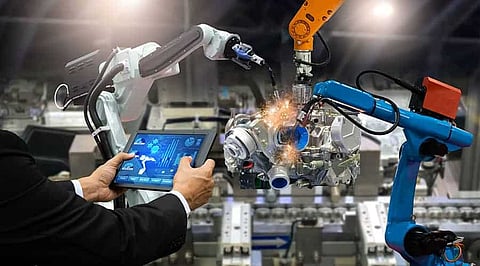

The manufacturing industry has always been at the forefront of adopting new, innovative technologies. From AI, IoT, and cloud, to sensors and connected devices, all are delivering significant value for manufacturers. Thanks to advances in technology, robotics has now come to the fore playing a vital role in manufacturing processes. Increasing interest from major manufacturers and the rapid demand for heavy payload robots strengthen the robotic market. Robotics has ventured into a variety of industries to drive better efficiency. Specifically, in the manufacturing field, its advent is quite commendable. For example, for its assembly line, Henry Ford inherited stationary robotic units that are positioned "behind the fence" and away from humans. This allows the robots to do their work without harming workers. Such robots are extremely energetic and don't get fatigued. This is what personifies efficiency.
Arc welding is the use of mechanized programmable tools (robots), which completely automate a welding process by both performing the welding and handling the part. Processes such as gas metal arc welding, while often automated, are not necessarily equivalent to robot welding, since a human operator sometimes prepares the materials to be welded. Robot welding is commonly used for resistance spot welding and arc welding in high production applications, such as the manufacturing industry.
Painting robots are used by vehicle manufacturers to do detailing work on their cars consistently and systematically. Industrial paint robots are designed to help standardize the distance and path the automatic sprayer takes. Eliminating the risk of human error is caused by manual spraying. Paint robots are often paired with other automatic painting equipment to maximize the efficiency and consistency of the paint finish.
Spot welding (or resistance spot welding) is a type of electric resistance welding used to weld various sheet metal products, through a process in which contacting metal surface points are joined by the heat obtained from resistance to electric current. The process uses two shaped copper alloy electrodes to concentrate welding current into a small "spot" and to simultaneously clamp the sheets together. Work-pieces are held together under pressure exerted by electrodes.
Robots are being used to handle a steadily widening range of products from blood samples to large crates. It includes mainly products and materials that require steadiness or dangerous products that could risk contamination if in contact with humans. The robots never get tired or make a mistake while performing their basic functions, and this solution also reduces the dangers of putting human workers' lives at risk. More work is completed via robots, and fewer workers are required to oversee the operation.
The most critical portion of maintenance work is an inspection to detect cracks, flaws, debonds, delamination, corrosion, and other detrimental changes. It is another area of factory operations in which the utilization of robots is growing. In a typical inspection job, the robot positions a sensor concerning the work part and determines whether the part is consistent with the quality specifications.
If the sequence of elements in the cycle is the same, and the elements consist of relatively simple motions, a robot is usually capable of performing the work cycle with greater consistency and repeatability than a human worker. Greater consistency and repeatability are usually manifested as higher product quality than can be achieved in a manual operation.
The integration of parts in various subsystems of production is an important application where robots can function more efficiently and with extra speed, thus assisting in the increase of production rate. Presently, robots are being used for tightening bolts and nuts, placing components in circuit boards, and a variety of other similar tasks. Logic devices are used for the identification and rectification of defects or inconsistencies.
Assembly robots are used for lean industrial processes and have expanded production capabilities in the manufacturing world. An assembly line robot can dramatically increase production speed and consistency. They also save workers from tedious and dull assembly line jobs. End of arm tooling can be customized for each assembly robot to cater to the manufacturing requirements.
Autonomous mobile robots (AMRs) and other automated vehicles, such as forklifts, can be used in a factory setting to move raw materials and other parts from storage areas to the factory floor. In Spain, for example, the Ford Motor Co. recently adopted AMRs from Mobile Industrial Robots (MiR) to deliver industrial and welding materials to various robot stations on the factory floor, replacing a manual process.
A light industrial robotic arm with "eyes" can do more precise work because it can "see" what it's doing. The robot wrist carries the laser and camera array that gives the machine instant feedback. Robots can now perform proper offsetting when installing a part because they know where it goes. Installation of door panels, windshields, and fenders are more accurate with robotic vision than regular robot arms.
Robots are currently widely used for component manufacturing. However, a potential area of expansion is product assembly. Before this, robots used to lack the dexterity needed to replace human hands. But with technologies like the multi-axis arm movement, human dexterity can be replicated with robotic equipment. They can also be quickly reconfigured to support today's shorter product life cycles. This improves efficiency and reduces production time. Robotics in the manufacturing market was valued at US$28.9 million in 2019, and it is estimated to grow at a CAGR of 9.5% during 2020-2025. The advent of numerous sorts of techniques committed to production control and the introduction of automation solutions are the key components of present production improvement policies.
Join our WhatsApp Channel to get the latest news, exclusives and videos on WhatsApp
_____________
Disclaimer: Analytics Insight does not provide financial advice or guidance. Also note that the cryptocurrencies mentioned/listed on the website could potentially be scams, i.e. designed to induce you to invest financial resources that may be lost forever and not be recoverable once investments are made. You are responsible for conducting your own research (DYOR) before making any investments. Read more here.
